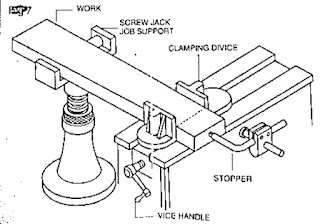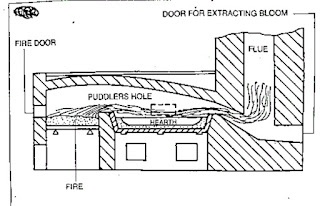Lathe accessories -4 jaw and 3 jaw chuck
. corridor of a 4 jaw chuck and 3 jaw chuck
.features of a 4 jaw chuck and 3 jaw chuck
4 jaw chuck
The four jaw chuck is also called as independent chuck, since each jaw can be acclimated singly; work can be trued to within0.001"or0.02 mm delicacy using this chuck.
This type of chuck is much more heavily constructed than the tone- centering chuck, and has much lesser than holding power. Each jaw is moved singly by a square thread screw. The jaws are reversible for holding large periphery jobs. The independent 4 jaw chuck has four jaws, each working singly of the others in its own niche in the chuck body and actuated by its own separate square threaded screw. By suitable adaptation of the jaws, a workpiece can be set to run either true or eccentric as needed.
To set the job for the alternate time, it can be trued with the help of a dial test index.
The check on the workpiece should be carried out near the chuck and repeated as far from it as the workpiece permits, to insure that the work isn't held in the chuck at an angle to the axis of gyration.
The independent adaptation also provides the installation of designedly setting the work off- centre to produce an eccentric workpiece.
The corridor of a 4 jaw chuck are
- reverse plate
- body
- jaws
-square threaded screw shaft
Back plate
The reverse plate is fastened to the reverse of the body by means of allen screws. It's made out of cast iron/ sword. Its drag is phased to suit the taper of the spindle nose. It has a crucial- way which fits into the crucial handed on the spindle nose. There's a step in front and on which the thread is cut. A threaded collar, which is mounted on the spindle, locks the chuck by means of the thread, and locates by means of the taper and key. Some chucks don't have back plates.
Body
The body is made out of cast iron/ cast sword and the face is honey- hardened. It has four openings at 90 ° piecemeal to assemble the jaws and operate them. Four screw shafts are fixed on the fringe of the body by means of cutlet poins. The screw is rotated by means of chuck key. The body, concave in the cross section, has equi-spaced indirect rings handed on the face, which are marked by numerical figures. Number 1 starts in the middle, and increases towards the fringe.
Jaws
Jaws are made out of high carbon sword hardened and tempered, which slide on the opening of the body. These jaws are reversible for holding concave work.
The aft side of the jaws are square threaded which hepls in fixing the jaws with the operating screws.
Screw shaft
The screw shaft is made out of high carbon sword, hard ened, tempered and ground. The top portion of the screw shaft is handed with a squre niche to accommodate the chuck key. On the body portion, a left hand squre thread is cut in the middle of the screw shaft, a narrow step is made and held by means of cutlet legs. The cutlet legs permit the screws to rotate but not to advance
3 jaw chuck
The 3 jaw chuck is also known as a tone centering chuck. The maturity of the chucks have two sets of jaws for holding internal and external periphery. Only perfect round work with inversely spaced apartments separable by three should be held in a 3 jaw chuck.
From the construction of a 3 jaw chuck is seen that the scroll not only clamps a element in place, it also locates the element. This is unnaturally a bad practice, since any wear in the scroll and or the jaws impairs the delicacy of position. Further there's no means of adaptation possible to compensate for this wear.
The jaws of this type of chuck aren't reversible, and seperate internal and external jaws have to be used.
The corridor of a 3 jaw chuck are
Back plate
Body
Jaws
Crown wheel
Pinion
Back plate
The reverse plate is fastened at the reverse of the body by means of allen screws. It's made out of cast iron. Its drag is phased to suit the taper of the spindle nose. It has a crucial- way which fits into the crucial handed on the spindle nose. There's a step in the front on which the thread is cut. The threaded collar, which is mounted on the spindle, locks the chuck by means of the thread and locates by mean of the taper and the key.
Body
The body is made out of cast sword, and the face is hardened. It has three opening 120 ° piecemeal to assenble the jaws and operate them. Three pinions are fixed on the fringe of the body to operate the jaws by means of a chuck key. It's concave in its cross section. A crown wheel is housed inside the body.
Jaws
The jaws are made out of high carbon sword, hardened and tempered, which slide on the opening of the body. Generally there are two sets of jawsviz. 1 external jaws and 2 internal jaws. External jaws are used for holding solid workshop. Way on the jaws increase the setting range. The aft side of the jaws is cut with scroll thread. Each jaw is numbered in a successional manner, which helps in fixing the jaws in the corresponding numbered places.
Crown wheel
The crown wheel is made out of allow sword, hardened and tempered. On one side of the crow wheel a scroll thread is cut to operate the jaws, and the other side is phased on which the bevel gear teeth are cut to mesh with pinion. When the pinion is rotated by means of a chuck key, the crown wheel rotates, therefore causing the jaws to move inward or outward, depending upon the gyration.
Pinion
Pinion ia made out of high carbon sword, hardened and tempered. It's fitted on the fringe of the body. On the top of the pinion a square niche is handed to accommodate the chuck key. It has a phased portion on which bevel gear teeth are cut, which match with the crown wheech
Comparison between 3 jaw chuck and 4 jaw chuck
3 jaw chuck
Only cylidrical, hexagonal work can be held.
Internal and external jaws are available.
Lower absorbing power.
Depth of cut is comparatively less.
Heavier jobs can not be turned.
Workpieces can not be set for eccentric turning.
Concentric circles aren't handed on the face.
Delicacy decreases as the chuck get worn out.
4 jaw chuck
A wide range of regular and irregular shapes can be held.
Jaws are reversible for external and internal holding.
Setting up of work is delicate
Further absorbing power.
Further depth of cut can be given.
Heavier jobs can be turned.
Workpieces can be set for eccentric turning.
Concentric circles help for approximate setting of jaws.
There's no loss of delicacy as the chuck gets worm out
Merits of 4 jaw chuck
A wide range of regular and irregular shapes can be held.
Work can be set to run concentrically or eccentrically at will.
Has considerible absorbing power, and hence heavy cuts can be given.
The jaws are reversible for internal and external work.
Work can be readily performed on the end face of the job.
There's no loss of delicacy as the chuck gets wornout.
De-merits of a 4 jaw chuck
Workpieces must be collectively set.
The gripping power is so great that fine work can be fluently damaged during setting.
Merits of 3 jaw chuck
Work can be set easy
A wide rage of spherical and hexagonal work can be held.
Internal and external jaws are available.
De-merits of a 3 jaw chuck
Delicacy drop as chuck becomes worn out.
Run out can not be corrected
Only round hand hexagonal factors can be held.
When accurate setting or concentricity with a being periphery is needed, a tone centering chuck isn't used.

















































